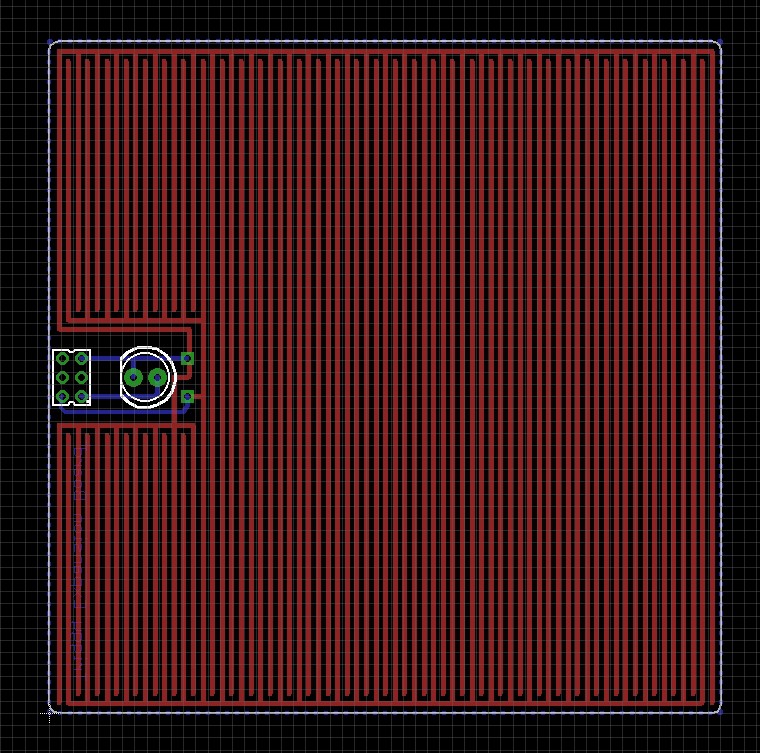-
First demo in real conditions
10/10/2016 at 21:48 • 0 commentsIt's here now: a video showing Triggy in action through two IFTTT recipes. I also give instructions on how to create a recipe on www.ifttt.com. The prototype is functional for a while now, but it doesn't have all features. After many trials of different video editors, I chose VSDC free video editor. I've found it both easy to use and powerful, at least perfect for what I wanted to do.
-
New Recipes Collection
09/29/2016 at 20:29 • 0 commentsThe firmware and Android app will soon be functional, but before showing a video with IFTTT in action, here are some new recipes with Triggy as the source of the events.
![]() Simply stick a module on the cat flap. When it moves, a notification is sent. You can also record the time of all these movements directly on a cloud service of your choice.
Simply stick a module on the cat flap. When it moves, a notification is sent. You can also record the time of all these movements directly on a cloud service of your choice.
![]() With Triggy and Manything app, the camera of a spare phone will start recording a video if someone opens unexpectedly a cupboard or a drawer. Who put his nose in your stuff?
With Triggy and Manything app, the camera of a spare phone will start recording a video if someone opens unexpectedly a cupboard or a drawer. Who put his nose in your stuff?
![]() Never forget to close a door or a window for the night. Every day at 10 pm (for example), you will receive a notification if the "open" position is detected.
Never forget to close a door or a window for the night. Every day at 10 pm (for example), you will receive a notification if the "open" position is detected.
![]() With a module stuck on your guitar, you can automatically inform your friends on Twitter or other social network that you start playing, as the displacement is detected.
With a module stuck on your guitar, you can automatically inform your friends on Twitter or other social network that you start playing, as the displacement is detected.
![]() If your car is moved in the street, you could know it instantly, even if far away. Just let the connected Android device in the car too.
If your car is moved in the street, you could know it instantly, even if far away. Just let the connected Android device in the car too.
![]()
You may want to know when an icebox with your picnic inside is heating up, indicating that it's time for lunch...
-
DIY enclosure
09/07/2016 at 20:21 • 0 commentsNow that the prototype board is fully functional, I decided to create a nice looking enclosure for it. Of course, 3D printers are the most appropriate tool for this purpose, but I have no access to a 3D printer and also I've never used one. I can only spend a limited amount of time for it, so the best solution I found, for now, is to make it with cardboard paper. The dimensions of the board are small enough to obtain a quite strong enclosure even with paper.
My experimentations showed that a paper of 270 g/m2 is enough, and still can be used with most inkjet printers.
![]() This is the equipment used and the result obtained once printed and cut
This is the equipment used and the result obtained once printed and cut
I used the following equipment, in addition to an inkjet printer:
- An A4, 270 mg/m2 paper sheet
- An iron ruler
- A box cutter
- Wood glue
The result
![]() The enclosure once folded and glued
The enclosure once folded and glued
![]() The triggy board in its box
The triggy board in its box
I've put the printable pdf files of the enclosure (front and back) in the files list. It has correct sizing for A4 paper.
-
IFTTT Recipes with Expansion Board
08/20/2016 at 12:06 • 0 commentsThe first expansion board built for Triggy (see first project log) adds the rain/water and ambient light sensors. This board further extends the possibilities and service provided by the system. See hereafter few IFTTT Recipes made possible.
![]() As soon as the first drop of rain is detected, receive an SMS reminding you to close the roof windows or to pick up the clothes drying outside.
As soon as the first drop of rain is detected, receive an SMS reminding you to close the roof windows or to pick up the clothes drying outside.
![]() You may have a tap leaking so slowly that you cannot keep watching it. Use Triggy to log any drop falling.
You may have a tap leaking so slowly that you cannot keep watching it. Use Triggy to log any drop falling.
![]() It's preferable to irrigate the garden once the sun is setting down, but the real time change every day. Triggy and a smart irrigation system can do the job.
It's preferable to irrigate the garden once the sun is setting down, but the real time change every day. Triggy and a smart irrigation system can do the job.
![]() For the romantics, Triggy can warn you when the sun starts to go down.
For the romantics, Triggy can warn you when the sun starts to go down.
-
First Demonstration Video
08/16/2016 at 20:59 • 0 commentsHere is a video showing the Triggy device in action, connected to the Android application running on a nexus 7 tablet. The goal of the video is to show the movement detection and how the displacements are logged into the app. Note that the application is the part of the project which will evolve the most. An other video showing actions triggering through IFTTT will be done later, once all this is more mature.
-
Power Consumption Table
08/13/2016 at 20:30 • 0 commentsNow that we have optimized the firmware embedded on the nRF52832, we are able to perform nearly final power consumption measurements. These have been done in all three modes of operation. The connected mode consumption has been measured with a Nexus 7, Android 6.0. The battery life is given for an "ideal" discharge of a CR2032 battery. Here are the figures:
![]()
- First we can see the interest of the shutdown mode: the consumption becomes negligible so that the battery can be left in the holder, avoiding handling the module unnecessarily. This mode is entered through the app or with a long push on the button.
- The UNCONNECTED and CONNECTED modes consumptions are almost the same, whereas normally it should be lower when connected to another BLE device. This is because the advertising interval of the unconnected mode has been increased to 2 seconds. The drawback is a longer time to enter in the connected mode, but at the end that's not really problematic and seems to be an acceptable connection delay.
- The consumption of the movement sensor is nearly half of the total. By default this sensor will not be enabled, and it should be only if the displacement trigger is required on a given device.
- With all triggers enabled, we can consider having a battery life around one year and a half, which is really good for this kind of sensor.
-
New Fresh Recipes
08/08/2016 at 19:29 • 0 commentsHere are new IFTTT Recipes enabled by the Triggy module. More to come thanks to the expansion board...
![]() This is only allowed by Triggy, thanks to its size: stick a module on the cat flap, and get notified when it moves, i.e. when your cat is entering or leaving the house.
This is only allowed by Triggy, thanks to its size: stick a module on the cat flap, and get notified when it moves, i.e. when your cat is entering or leaving the house.
![]() With a module on your guitar, you can automatically inform your friends on Twitter or any other social network that you start playing, moving the guitar from its regular position.
With a module on your guitar, you can automatically inform your friends on Twitter or any other social network that you start playing, moving the guitar from its regular position.
![]() Never forget to close a door or window for the night. Every day at 10 pm, you will receive a notification if the "open" position is detected.
Never forget to close a door or window for the night. Every day at 10 pm, you will receive a notification if the "open" position is detected.
-
Expansion board prototype
08/06/2016 at 21:04 • 0 commentsThe first expansion board is ready and seems functional.
Only 2 components need to be soldered: the 6-pin header (male) to be plugged on the main Triggy board, and the light sensor. The remaining part of the board is the rain/water sensor. It is composed of an anode and a cathode with interlaced copper traces (spacing ~0.5 mm). This allows first the first drop of water to be detected. This has been confirmed by measuring the resistance between the 2 inputs.
The dimensions of this board are 7 cm x 7 cm. This area is a good compromise between cost and ability to quickly detect when it starts to rain.
Some resistors need to be put in series with the two sensors: theses have been soldered on the Triggy board. We measure then a variation of voltage through the ADC available on the nRF52832.
Next step: develop the firmware to support these new sensors and trigger an action on the next rain.
![]()
Triggy - Sensor Node for Life Automation
A smart sensor Node to trigger an action on a smartphone each time a physical change is detected (temperature, displacement, click...)
 Vinch
Vinch Simply stick a module on the cat flap. When it moves, a notification is sent. You can also record the time of all these movements directly on a cloud service of your choice.
Simply stick a module on the cat flap. When it moves, a notification is sent. You can also record the time of all these movements directly on a cloud service of your choice.
 With Triggy and Manything app, the camera of a spare phone will start recording a video if someone opens unexpectedly a cupboard or a drawer. Who put his nose in your stuff?
With Triggy and Manything app, the camera of a spare phone will start recording a video if someone opens unexpectedly a cupboard or a drawer. Who put his nose in your stuff?
 Never forget to close a door or a window for the night. Every day at 10 pm (for example), you will receive a notification if the "open" position is detected.
Never forget to close a door or a window for the night. Every day at 10 pm (for example), you will receive a notification if the "open" position is detected.
 With a module stuck on your guitar, you can automatically inform your friends on Twitter or other social network that you start playing, as the displacement is detected.
With a module stuck on your guitar, you can automatically inform your friends on Twitter or other social network that you start playing, as the displacement is detected.
 If your car is moved in the street, you could know it instantly, even if far away. Just let the connected Android device in the car too.
If your car is moved in the street, you could know it instantly, even if far away. Just let the connected Android device in the car too.

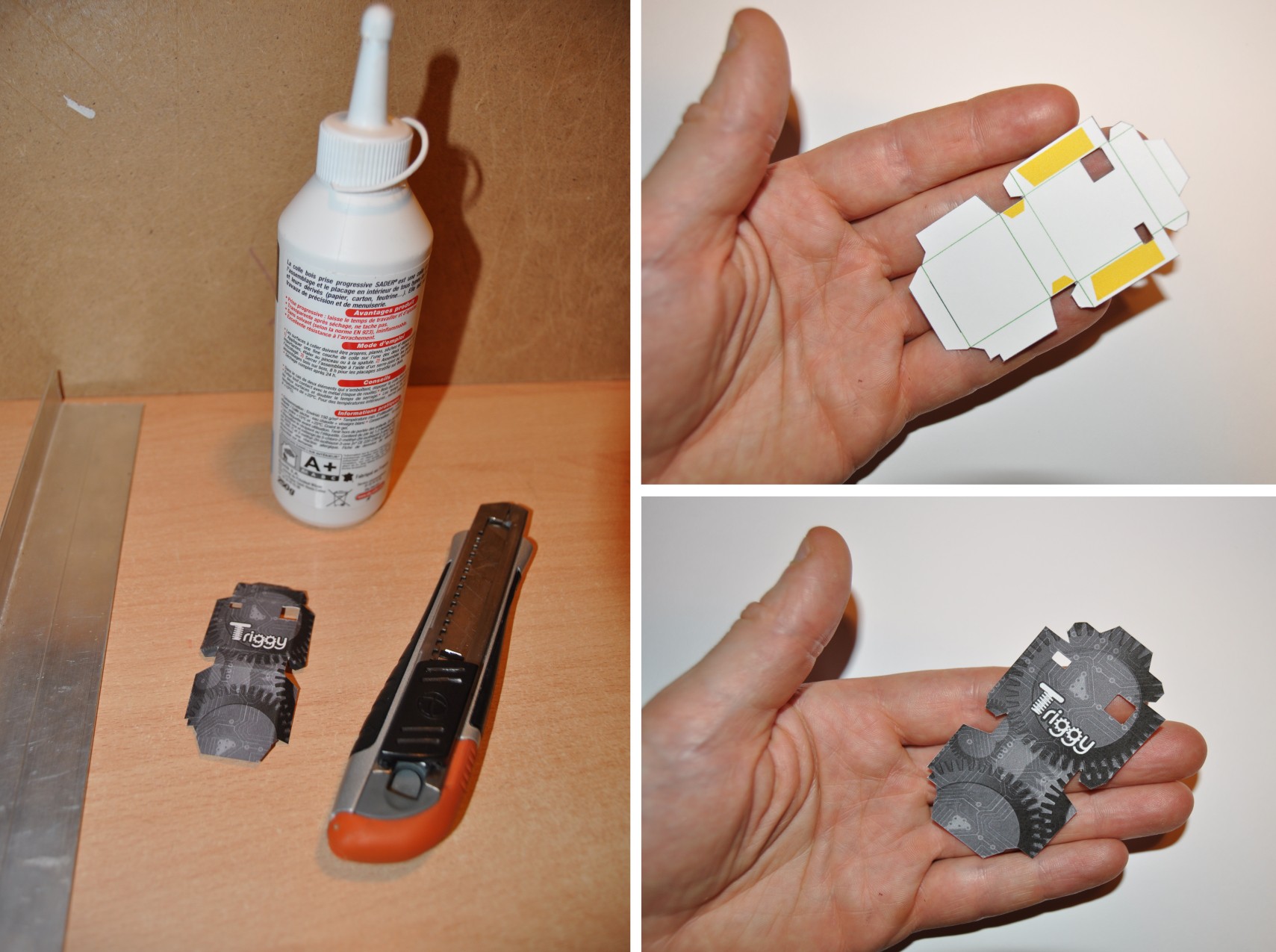 This is the equipment used and the result obtained once printed and cut
This is the equipment used and the result obtained once printed and cut
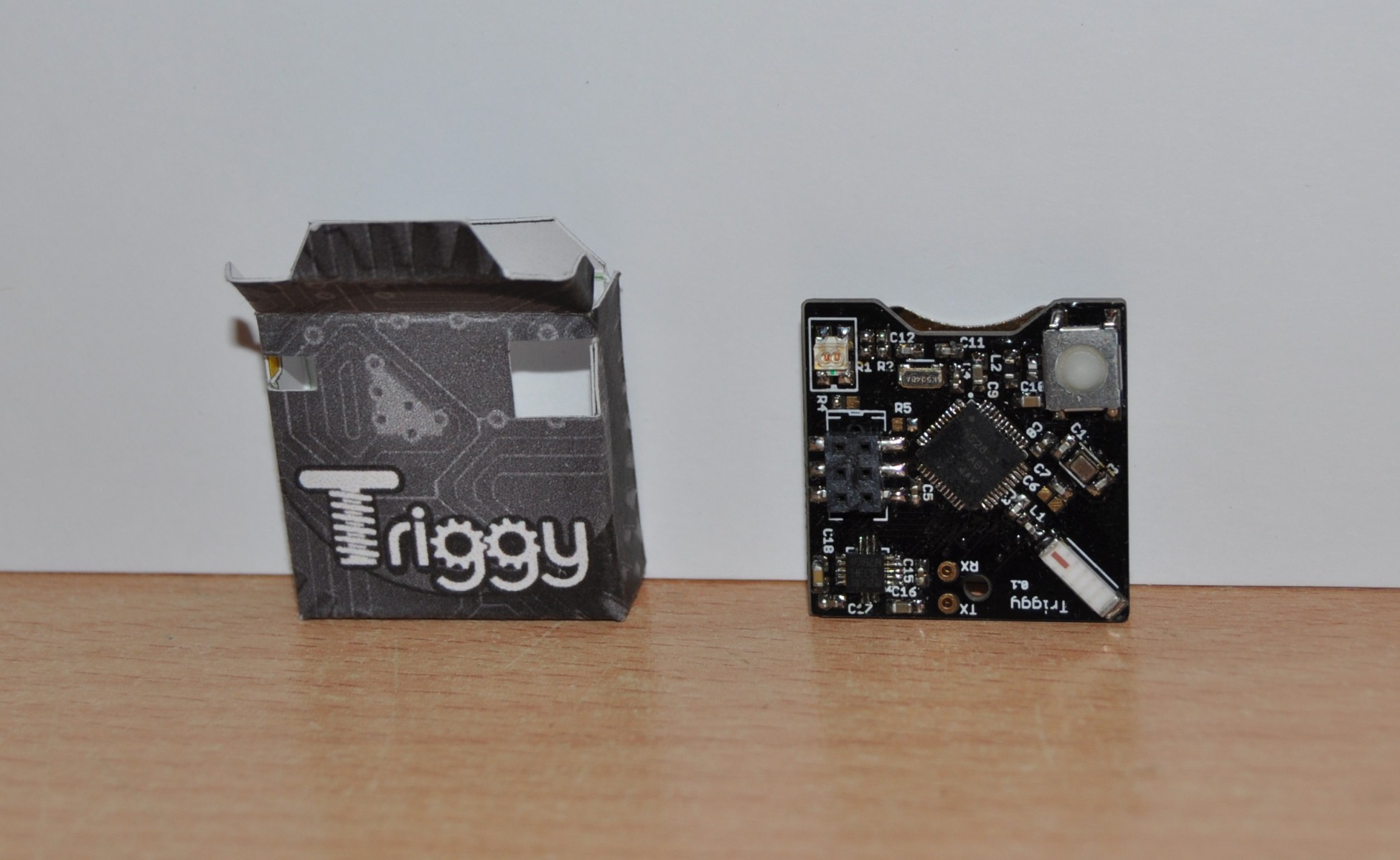 The enclosure once folded and glued
The enclosure once folded and glued
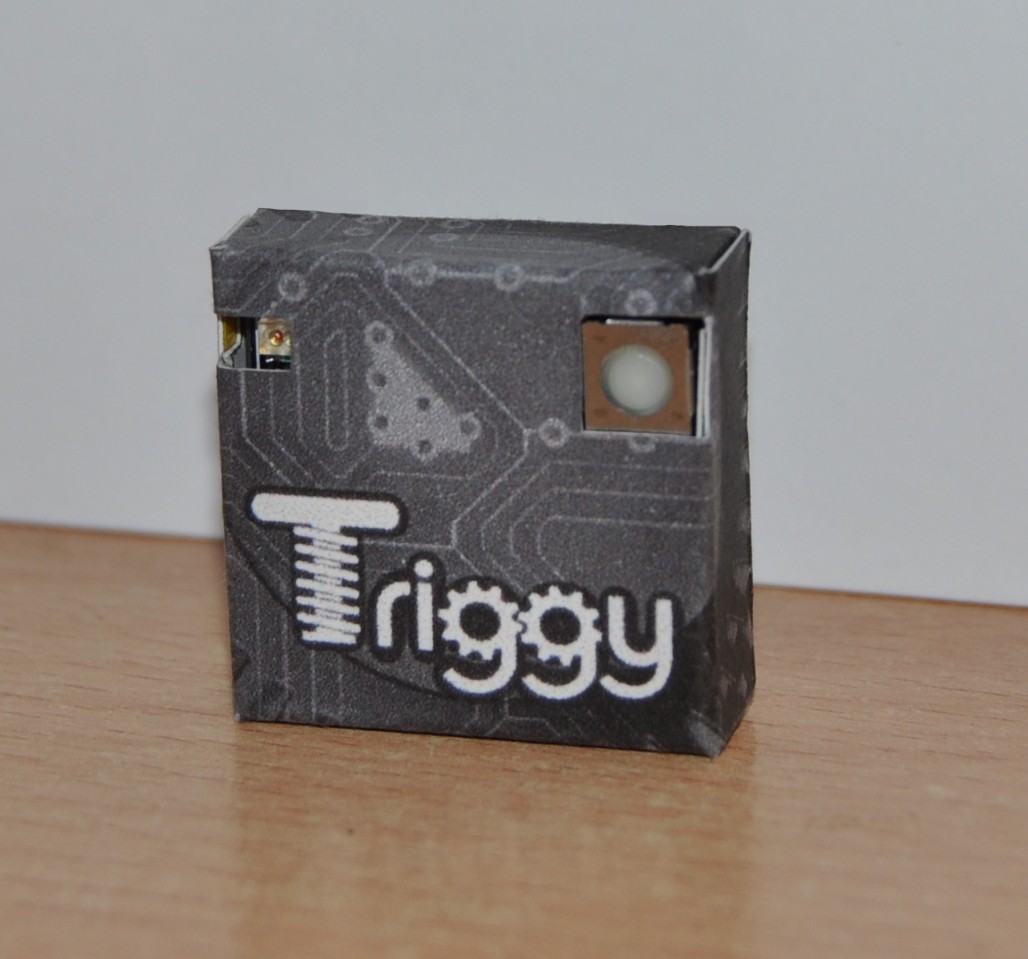 The triggy board in its box
The triggy board in its box
 As soon as the first drop of rain is detected, receive an SMS reminding you to close the roof windows or to pick up the clothes drying outside.
As soon as the first drop of rain is detected, receive an SMS reminding you to close the roof windows or to pick up the clothes drying outside.
 You may have a tap leaking so slowly that you cannot keep watching it. Use Triggy to log any drop falling.
You may have a tap leaking so slowly that you cannot keep watching it. Use Triggy to log any drop falling.
 It's preferable to irrigate the garden once the sun is setting down, but the real time change every day. Triggy and a smart irrigation system can do the job.
It's preferable to irrigate the garden once the sun is setting down, but the real time change every day. Triggy and a smart irrigation system can do the job.
 For the romantics, Triggy can warn you when the sun starts to go down.
For the romantics, Triggy can warn you when the sun starts to go down.
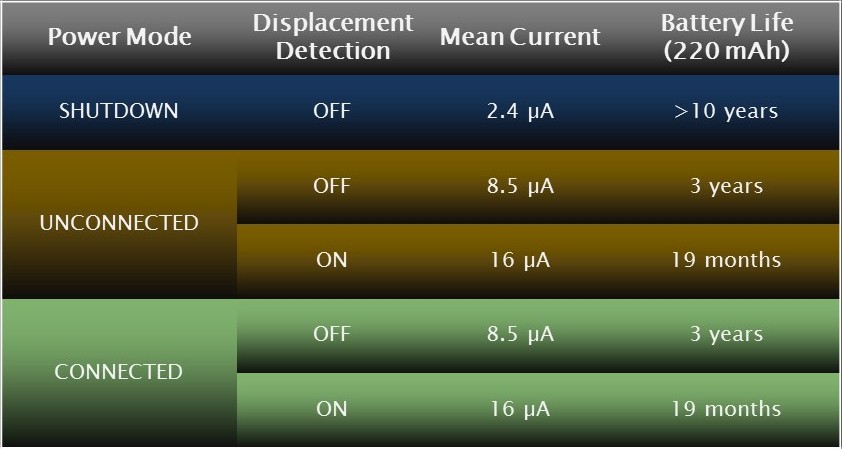
 This is only allowed by Triggy, thanks to its size: stick a module on the cat flap, and get notified when it moves, i.e. when your cat is entering or leaving the house.
This is only allowed by Triggy, thanks to its size: stick a module on the cat flap, and get notified when it moves, i.e. when your cat is entering or leaving the house.
 With a module on your guitar, you can automatically inform your friends on Twitter or any other social network that you start playing, moving the guitar from its regular position.
With a module on your guitar, you can automatically inform your friends on Twitter or any other social network that you start playing, moving the guitar from its regular position.
 Never forget to close a door or window for the night. Every day at 10 pm, you will receive a notification if the "open" position is detected.
Never forget to close a door or window for the night. Every day at 10 pm, you will receive a notification if the "open" position is detected.
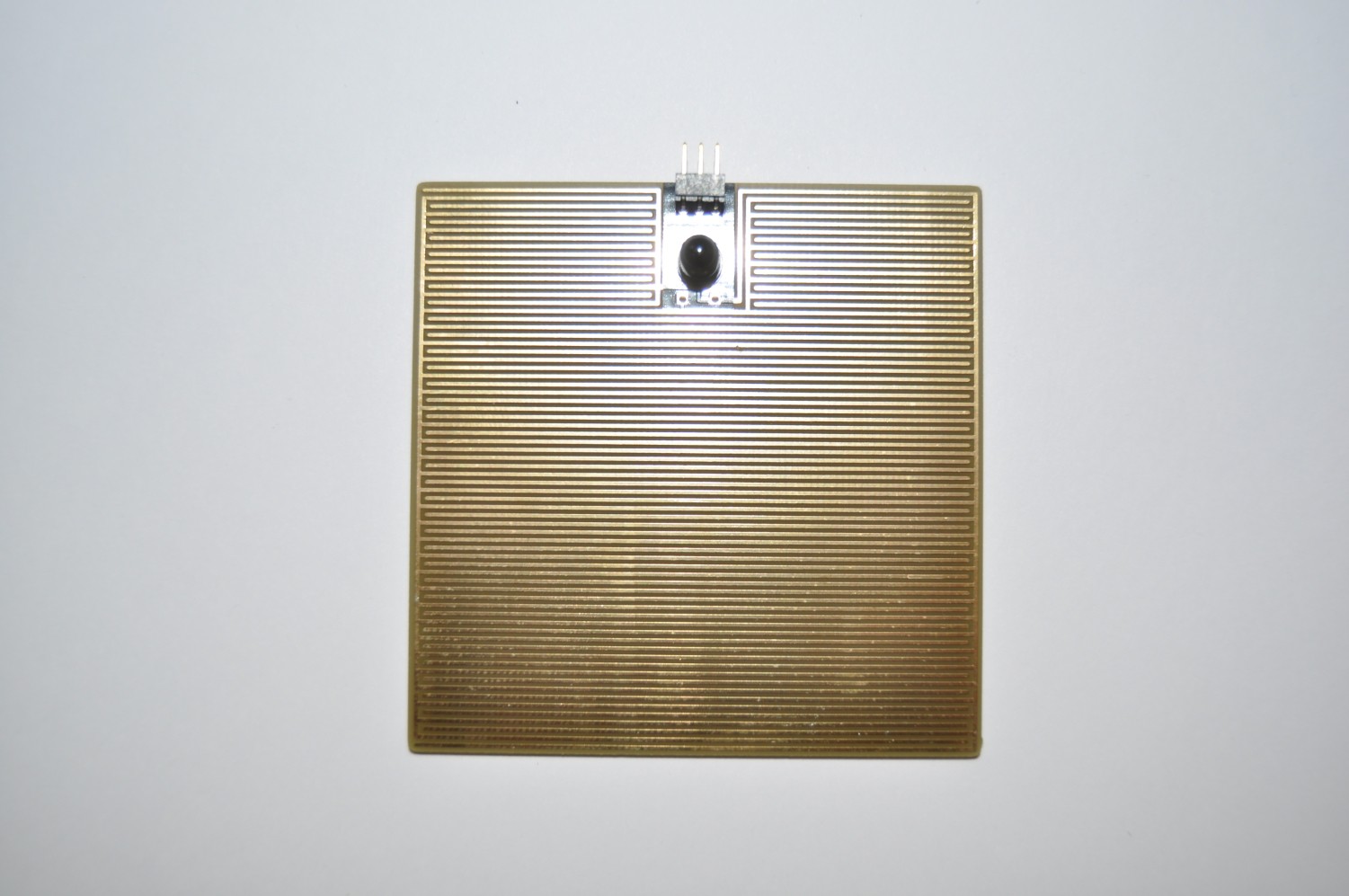 Some resistors need to be put in series with the two sensors: theses have been soldered on the Triggy board. We measure then a variation of voltage through the ADC available on the nRF52832.
Some resistors need to be put in series with the two sensors: theses have been soldered on the Triggy board. We measure then a variation of voltage through the ADC available on the nRF52832.